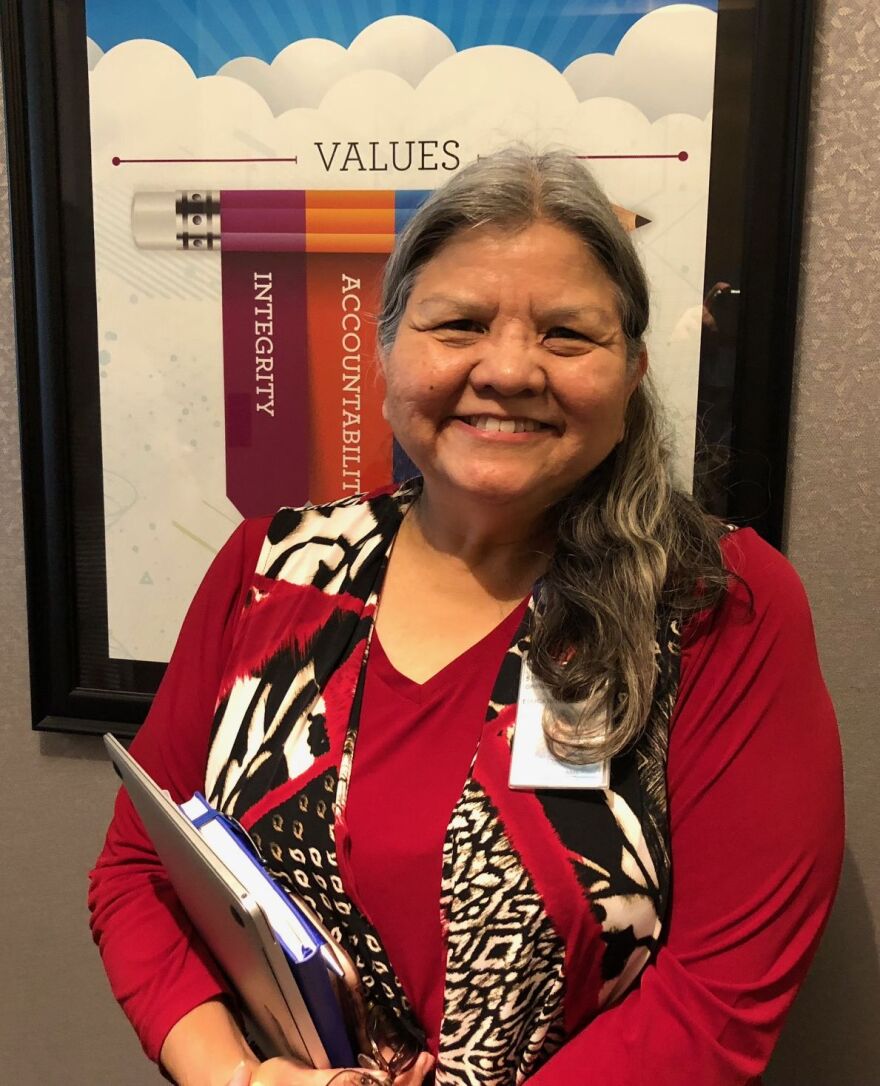Oregon’s Native American students largely struggle to keep pace with their non-Indian peers. Graduation rates and attendance are low, while dropouts are high. In this months’ segment for the series, “Native Voices of Oregon” KLCC’s Brian Bull talks to Indian educators about the challenges their students face, and what’s being done to brighten their prospects.
Inside an old school building, a dozen children with safety goggles and chisels chip away at a large cedar log. It’ll eventually become a totem pole. The project is part of the weekly NATIVES program*, through the 4-J School District of Eugene.

Joe Brainard, an Apache Indian and mentor for NATIVES, says the pole will be given to Sheldon High School when done.
“We want people to know that we respect the community, and we as the community to respect also us, by observing the pole and taking care of it,” he says.
Respect is a value emphasized with all NATIVES students. Down the hall, another group of children practice drumming.

Erika Moe, a Chippewa Indian from Wisconsin, says mutual respect hasn’t always been easy to come by…like when NATIVES did an afterschool presentation.
“When we were drumming, this kid started like, mocking us,” recalls Moe. “That wasn’t very nice. Dancing around like an idiot. Like trying to make fun of us.
"A lot of people didn’t try to stop the guy, so then Joe Brainard had to go over, and he was still bothering us.”

Moe says textbook portrayals of Indian history are scant and dry. She’s found more in-depth material through NATIVES, not to mention a sense of place.
There are about 30 such programs in Oregon, federally-funded through what’s called the Native American Education Title VI program.
“We want our children to find a community. To find their voice,” says NATIVES director Brenda Brainard.
A member of the Coos, Lower Umpqua, and Siuslaw Indians, she’s familiar with the challenges facing marginalized communities.

“They don’t quite have enough food, they don’t quite have good enough housing,” says Brainard. “They always have needs that aren’t being met. And when they’re stressing over food stamps being cut or losing their housing, it’s hard to keep them engaged in school.”
The rough math of economic hardship, racially indifferent or hostile environments, and lack of cultural connection adds up to some harsh numbers for Oregon’s Native American students.

“For community colleges, our Native American students graduated at a 36 percent rate compared to 46 percent of their peers,” says Mona Halcomb, an Indian Education Specialist with the Oregon Department of Education.
“And 39 percent of first-time college students that were American Indian/Alaskan Native earned a BA compared to 63 percent of their peers.”
For high school, Oregon’s native students have a 59 percent graduation rate…compared to 74 percent statewide. That rate’s actually up from four years ago.

Halcomb – a member of the Umatilla Tribe - has this perspective.
“I am happy every time an American Indian graduates. Whether that’s high school or college,” she tells KLCC.
“I know 59.1 percent is nothing to brag about, but I’m going to celebrate 59 percent, because those are students who made it through a very difficult journey.”
Another finding…in 2014, a third of native students were chronically absent, compared to 19 percent of their peers.
Halcomb says family advocates have helped families structure their kid’s schedules, with reinforcement through recognition. She says colorful “brag tags” celebrating a student’s attendance have helped bring absenteeism down a few points.

Halcomb recalls visiting a school and bumping into a success story.
“This little 4th grader was running up to show his principal, ‘Look! I’ve got November’s tag!’ and he was all happy,” she says.
“And I had a parent come up to me –with tears – we gave a simple certificate, that said, ‘Your child has improved attendance’. And this parent had tears, and said, ‘My child’s never been recognized for anything.’”

April Campbell is Indian Education Advisor for the ODE, and a member of the Confederated Tribes of the Grande Ronde. She says the next big thing is Senate Bill 13.
Signed into law by Governor Kate Brown last year, it will create an American Indian curriculum for the state’s 4th, 8th, and 10th grades.
“Although American Indians have rich histories, these people are often referred to in historical terms,” says Campbell. “So this is an opportunity to let students know there are thriving American Indian tribes and tribal communities here in Oregon.”
Oregon’s nine federally-recognized tribes and the state are still collaborating on the curriculum for Senate Bill 13. Roll-out’s expected next summer.
Campbell says another effort by the state – called the Educator Equity Committee – aims to increase teachers of color across Oregon.
“Research shows that if students are taught by folks who look like them, that may have come from a similar culture or background as them, they’re more likely to engage.”

For Janiya Taylor, it’s all good. A member of the Tolowa Yurok tribe, the eleventh grader at North Eugene High School says these efforts will improve Oregon’s education system, and let native students feel a sense of belonging and pride.
“Be proud of who you are,” says Taylor. “And I am native first, or I am First Nation. And you should always say that because you were here first, and you don’t want other people to forget that.
“And…it just makes me happy,” Taylor adds, with a smile.
* Note: Reporter Brian Bull has relatives involved with the NATIVES program.
Funding for KLCC’s “Borders, Migration, and Belonging” series provided by the Wayne Morse Center for Law and Politics at the University of Oregon.
Copyright 2018, KLCC.









